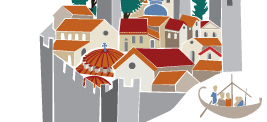Cities
The Byzantine Empire during the first
centuries of its existence consisted mostly of cities that, having survived
from antiquity, were strongly influenced by the spirit of the ancient world,
which was reflected in their urban structure.
More than 900 cities, the largest of which was Constantinople, Alexandria and
Antioch, were recorded in the East in the sixth century. The leading part that
the Church and central power played in the public life, as well as the form of
houses, streets and squares that were among those affected by the significant
changes occurring in structures and priorities of the city were the results of
the establishment of Christianity as the official religion of the state and the
gradual Christianization of the cities.
Since the Justinianian era, and particularly after the
9th century numerous town-castles, having as their main objective to protect
both the inhabitants and the borders from the enemy attacks, were built throughout
the Byzantine empire. The castles were built in naturally fortified locations,
on hilltops or mountaintops, from where the control of streets and passages of
the mainland was ensured. On the exterior, the castles were protected by
fortification walls with towers, while in their interior paths beginning at the
gates of the fortress and leading to the settlement's areas were created. These
streets were generally narrow, steep and paved, while their width varied
depending on the available space. On both sides of the streets, houses of
usually one or two-storey high and in direct contact with each other were built.
era, and particularly after the
9th century numerous town-castles, having as their main objective to protect
both the inhabitants and the borders from the enemy attacks, were built throughout
the Byzantine empire. The castles were built in naturally fortified locations,
on hilltops or mountaintops, from where the control of streets and passages of
the mainland was ensured. On the exterior, the castles were protected by
fortification walls with towers, while in their interior paths beginning at the
gates of the fortress and leading to the settlement's areas were created. These
streets were generally narrow, steep and paved, while their width varied
depending on the available space. On both sides of the streets, houses of
usually one or two-storey high and in direct contact with each other were built.
The unregulated structuring and the space constraints
that characterized the byzantine city-castles resulted in the lack of large
squares and designed open spaces. The available open spaces were restricted
around the temples, and the
enclosures of the monasteries that often functioned as areas of fairs, shopping
and socialιzing.
Gradually, these places became important areas of the social life in Byzantium
and were the nuclei around which the neighborhoods were organized. During the
late and especially the post-Byzantine period, parish churches gave their name
to the neighborhoods where they were built. In all Byzantine cities, both
inside and outside of the walls, monasteries were founded, which soon became
centers of intellectual life acquiring considerable economic and social power.
Bibliography (1)▼
Comments (0)▼
New Comment▼








